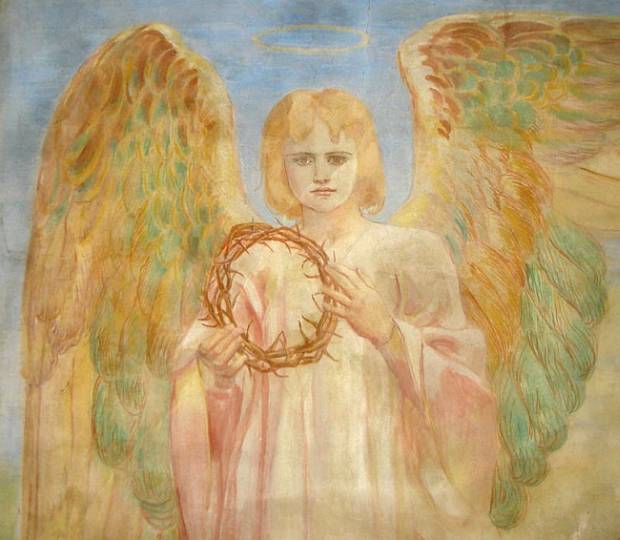
St Martin's Church, by Charles Harrison Townsend. Built 1892; dedicated 1893. Brick and other materials. Blackheath, Surrey. Photographs and text by Sarah Sullivan, 2011, whose copyright they remain.
The church of St Martin in Blackheath Village was very dear to Townsend and he was very proud of it. Originally envisaged as a Mission Hall on land acquired by William Chandler Roberts-Austen and designed along the lines of a wayside chapel, it is located at what was then a fork in the lane over open heathland, creating a visual focus and a natural stopping point in the valley. Services for the village had been started in 1890 by Roberts-Austen in what had been a squatter's cottage, and this later became the vestry.



Left to right: (a) Close-up of the church door. (b) The bellcote. (c) Plan of the church (drawn up by the present author).
The church was built by local builders, Messers Brown of Bramley, in 1892 at a cost of £600, and the building was dedicated by the Bishop of Winchester in July 1893. The most striking feature is the entrance arch, with its similarities to the work of the American architect Henry Hobson Richardson. Here is probably the first main example of the arch that would become a Townsend trademark.


Left to right: (a) Close-up of the barrel-vault. (b) Angel fresco in the chancel.
The interior is barrel vaulted and decorated with frescoes of the Life of Christ, painted by the American artist Anna Lea-Merritt (1844-1930) using Keim silicate mineral paint from Germany. These frescoes are one of the earliest uses of this paint in Britain and have stood the test of time. They were completed in 1895 and have a pleasant soft colouring in keeping with general design of the church. Ann Lea Merritt was the first female artist to have her work acquired for the nation through the Chantry Bequest and the painting, Love Locked Out, is in the Tate Collection. The wall paintings for the church were executed directly onto the wet plaster and her subjects are virtually life size using models from the village of Hurstbourne Tarrant.
The altar is top lit from the east by a concealed gable window to draw in the congregation and focus their worship. The walls are nearly one metre thick and are constructed with a skin of brickwork infilled with rubble and finished with a skim of render. This is protected by low hanging and projecting eaves with diagonally placed lining boards to add strength and support to the roof structure. The barrel vaulting internally of lathes and plaster is supported by a scissor brace arrangement shaped to form the curve. Simple clay pantiles provide the roof covering and a Baroque tower over the east end provides the bell housing in Ham Hill stone left roughly dressed alongside local brickwork. The golden hamstone has been described by Simon Jenkins as "the loveliest building material in England" and here at St Martin's it has been used to good effect.
A contemporary journalist for the German magazine, Moderne Bauformen, commented on Townsend's church: "There is nothing more enjoyable than his looking-like-a-barn church in Surrey. It is not possible to say whether the design has its origins in previous English churches." Others have been more forthright stating, for example: "The squat stuccoed and buttressed walls, massive round headed arched doorway and pantile roof topped with vestigial bell turret, all conspire to mark this out as a building not of this place. And yet it works." (Budgen)
Bibliography
Budgen, Christopher. West Surrey Architecture. Heritage of Waverley, 2002.
"C. Harrison Townsend." Moderne Bauformen, Monatshefte Für Architektur, Jahrgang V, Heft 11. (Modern Designs for Architecture Monthly [Stuttgart], Vol. 5 [1906], Book 11.).
Clarke, Meaghan. E, "Merritt, Ann Lea (1844-1930)." Oxford Dictionary of National Biography.
Jenkins, Simon. England's Thousand Best Churches. Rev. ed. London: Allen Lane, 2004.
Merritt, Anna Lea. "A New Mode of Decorating Church Walls." The Times. 24 October 1894.
_____ and Professor Roberts-Austen. "A Mural Painting Process." The Artist, 1896.
"Proposed Mission Chapel." The Building News. 7 October 1892.
Rivington, A. J. "A New Mode of Decorating Church Walls." The Times. 26 October 1894.
Roberts-Austen, W. C. Letters to the Editor. The Times. 30 October and 7 November 1894.
"St Martin's Church." Architectural Review (Surrey History Centre. Ref. 6526/8/1).
"St Martin's Church." The Builder. 30 October 1897.
Townsend, Charles Harrison. "A New Mode of Decorating Church Walls." The Times. 26 October 1894.
Last modified 14 April 2025